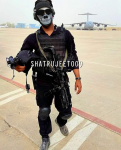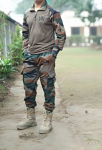Special Forces meant to do ops like surgical strikes. They’re called ‘special’ for a reason
Two incidents in recent days caught my imagination, both related to Para SF, the elite forces of the Indian army.
The first was an
encounter along the Line of Control in Jammu and Kashmir, where, in a close quarter fight, five fully-armed terrorists were eliminated. We also lost five Para SF soldiers — all belonging to the 4 Para Special Forces, which had undertaken the famed surgical strikes.
Second was the demise of a braveheart, Col Navjot Singh Bal, Shaurya Chakra, former commanding officer (CO) of 2 Para SF, who even in the ultimate test, stoically faced his fate, smiling, like the Warriors of Yore.
Many thoughts traversed my mind. What is that special ethos that motivates these men of the SF to make the ultimate sacrifice? I also ended up enquiring to a few SF Officers if the operation in J&K had proved rather costly? Shouldn’t we minimise our casualties?
Col Saurabh Shekhawat, KC, SC, SM, VSM, India’s highest decorated serving soldier replied cryptically: “Sir we do our best to minimise casualties through intense training and planning, but once the battle is joined, it’s
Vijay Ya Veergati (victory or martyrdom)
.”
Having had the good fortune to have some of the finest SF units under my command, including the Para Centre at Bangalore, I do have an idea what goes into the selection and making of a Para SF leader and soldier.
Raison d’être for Special Forces
Every nation needs to decide what its special forces are meant for. According to Stephen Cohen, “The task of special forces is the proxy application of force at low and precisely calculated levels, the objective being to achieve some political effect, not a battlefield victory”.
But, as Lt Gen P. C. Katoch, a war veteran of the SF, states: “In sharp contrast, in India, we have been simply looking at battlefield victory. SF units are deployed more on tactical missions rather than the broader, strategic and unconventional missions that should be their charter’’. Rahul Bedi also echoes the same in an
article in
The Citizen that the SF have often ended up as substitutes for conventional forces in counter-insurgency operations, for tasks that should be undertaken by regular infantry.
India’s Para SF are equipped reasonably, but not with the latest technology. It is time we provided them with the latest and the best that today’s revolution in military affairs offers: drones of all types, space and cyber-based applications among others.
Unconditional ownership of the SF
Combat has always been and continues to be most brutal, challenging, unforgiving and the ultimate test of the human spirit. This is also the raison d’être of the special forces, for they exist only for special missions and combat. Facing special challenges requires a very high level of individual proficiency in the skills peculiar to SF. But more than that, it’s the combined combat capabilities of the squad/team that matters more. And this calls for very high levels of trust and unconditional ownership of the plan and the follow-up action. Anything less would not do. This involves trusting your life with your buddy/squad and ownership of both success and failures, for no plan survives the first contact. In fact, there are more lessons to be learnt in failures.
The Indian Para SF holds the ethos of unconditional and extreme ownership. Trust, of course, is the glue that binds the SF together. Trust that has been earned and created through living and training together under most severe conditions for prolonged periods. Innovation, ingenuity, boldness and risk-taking ability are key facets of it.
Leadership is the ultimate force multiplier
Superlative leadership, especially at the officer’s level is the acknowledged hallmark of the Indian Army. Same is the case with the Para SF. But because of the decentralised nature of their operations, leadership at the JCO and NCO level becomes equally important. And these leaders have to deliver, for they are conscious of the fact that in the ultimate analysis what matters is the success of their mission. The SF junior leaders have to not only be masters of their trade, but also have the sharpness of intellect and battlefield intuition to put their finger on the right course of action, under severely stressful and time-constrained operational situations.
The SF officers are a breed apart, single-minded in their devotion to their profession, almost to an extreme. A large number of them have risen to high ranks, but some have also paid the price of not being able to adjust to life outside the uniform when they call it quits. And this is not peculiar to the Indian Para SF, but a phenomenon seen across the special forces in many nations. Lt Gen Vinod Bhatia, a para officer of repute and erstwhile DGMO, sums it up well: “A bunch of misfits who fit well together. For the hazardous tasks they are called upon to undertake, they have to be special in all respects’’.
Optimising the Para SF
Most Para SF Officers recognise that in peacetime, employment of SF in counter insurgency/counter terrorism (CI/CT) tasks gives them valuable combat experience. But continuous employment also detracts and is detrimental to their combat edge, attitude and training, required for the specialised tasks at operational/strategic levels in war. I would tend to agree that short-term focus should not govern the deployment and employment of SF in peacetime. Para SF is a very precious force multiplier and should be used judiciously.
The country must provide the SF, all that they need and more. The Defence Procurement Procedure must make a special provision for the SF. Anything less would be unacceptable dereliction on the part of those responsible. The SF should be provided the highest priority under the charter of the chief of defence staff and the department of military affairs. The equipment provided must be of top quality whether indigenous or from abroad. During the current pandemic crisis, where all procurement has been put on hold, the SF procurement should be allowed to proceed on fast track. The financial outgo would be limited.
AFSOD needs nurturing
The creation of the Armed Forces Special Operations Division (AFSOD) is a good first step to capitalise on the SF capabilities for strategic-politico-military tasks, including out of area contingencies.
While some dedicated allocations have been made from the SF of the three Services, it’s still a work in progress and needs careful nurturing, as also support from the three Services, especially the Army.
The AFSOD has great potential to fill the existing gap at the politico-strategic-military level. The importance of providing it with dedicated assets (including aircraft), intelligence on a regular basis and an SF adviser of appropriate rank cannot be overstated. In peacetime, we should also provide them with discreet exposure in countries of interest.
Minimising casualties
Most analysts tend to avoid this, not wanting to question the professionalism and sacrifice of officers and soldiers, including in Special Forces. Based on my own convictions, while in service and even now, I am quite convinced that the Indian Army is losing more soldiers in CI/CT operations than is desirable and maybe, some steps can be taken to minimise our casualties.
To get a correct understanding, let’s look at two perspectives with respect to Para SF.
The first is at the unit/lower level, where the ethos are
Balidan (sacrifice) and
Vijay ya Veergati. It is not possible for the CO of an SF unit to lower this very high benchmark and combine it with caution because, as any SF officer will tell you, once the battle is joined the focus is on getting the job done, efficiently and with a ruthless streak to eliminate the target. The SF have also undertaken a large number of clean operations with no casualties, but the risk is ever-present and part of the job. My concern is mostly at a higher level, where tasking is done and requisite support provided. It is for the senior leadership to ensure that the SF are used only for critical missions, and once the tasking is done, they are allowed to complete the task as they know best, without undue pressure of time/ deadlines.
This is a truth that needs to be acknowledged at the highest level and rectified. As a senior SF officer told me: losing a valuable officer or trooper in CI/CT operations is always painful, and it is for the senior officers to be mindful of this. Once the target/ terrorist is locked, we will get him, tomorrow, if not today.
The other responsibility on senior leadership is to provide the best technology in terms of UAVs/Drones and other surveillance, with a continuous live feed to the team undertaking the operation. This will certainly reduce unnecessary casualties. I am of the firm belief that gone are the days when a senior leader’s focus was “Mission at any cost”. Today we need military leaders who will accomplish the ‘’Mission at least cost’’.














